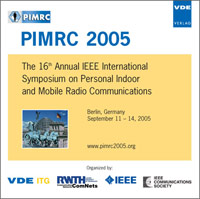A Cross-Layer On-Demand Routing Protocol for Delay-Sensitive Applications
Konferenz: PIMRC 2005 - 16th Annual IEEE International Symposium on Personal Indoor and Mobile Radio Communications
11.09.2005 - 14.09.2005 in Berlin, Germany
Tagungsband: PIMRC 2005
Seiten: 5Sprache: EnglischTyp: PDF
Persönliche VDE-Mitglieder erhalten auf diesen Artikel 10% Rabatt
Autoren:
Romdhani, Lamia; Bonnet, Christian (Institut Eurécom, France)
Inhalt:
Nowadays, the cross-layer design approach is an important concept in mobile ad-hoc networks which is adopted to solve several open issues. It aims to overcome MANET performance problems by allowing protocols belonging to different layers to cooperate and share network status informations while still maintaining separated layers. Indeed, the mechanisms on how to access the radio channel are extremely important in order to guarantee QoS and improve application performance. In this work, we present a Cross Layer routing protocol called CLAE which is based on the cooperation between the On-Demand AODV routing protocol and the new IEEE 802.11e MAC protocol (EDCA). This proposal aims to find the best path according to application requirements in terms of delay, bandwidth, route stability, etc. Without loss of generality, this paper focuses only on determining the path with the lowest delay. Each node periodically estimates the average transmission delay for each class of service defined by 802.11e. This information is injected into routing requests and replies crossing each node. The sender is then able to select the best path which fits its delay requirement. Furthermore, in order to overcome transient network characteristics due to new communications set up and mobility, we develop a new buffer management scheme for the audio class of service that aims to discriminate audio packets according to their tolerated end-to-end transfer delay and their current experienced delay. The simulation results demonstrate that our proposal improves the performance of delay-sensitive applications while maintaining a good packet delivery ratio of other traffics.


